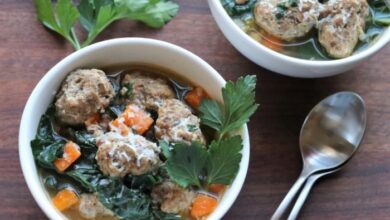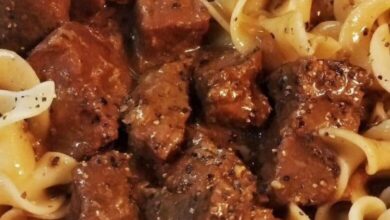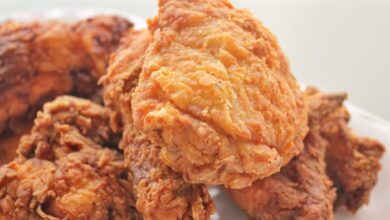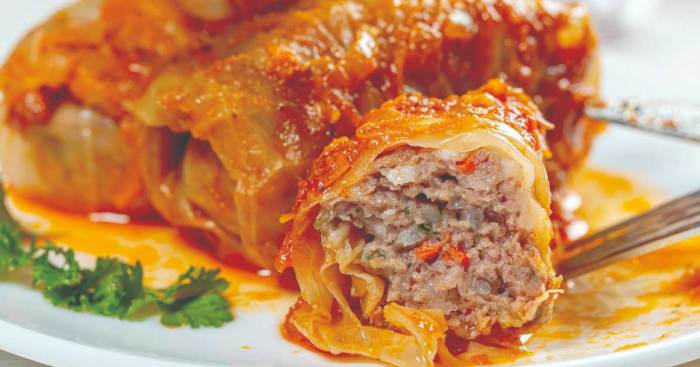
Stuffed Cabbage Rolls with Tomato Sauce: A Flavorful Journey
Stuffed cabbage rolls with tomato sauce are a culinary delight that transcends borders and generations. These savory parcels, often steeped in tradition and family recipes, offer a symphony of flavors that tantalize the taste buds. From the tender, slightly sweet cabbage leaves to the rich, meaty filling and the tangy, vibrant tomato sauce, each bite is a journey through a world of culinary artistry.
The origins of stuffed cabbage rolls can be traced back to various cultures, each adding its own unique twist to the dish. Whether it’s the comforting warmth of Eastern European cuisine or the vibrant spices of the Mediterranean, these rolls have become a staple in countless kitchens worldwide.
Today, we’ll explore the history, ingredients, and techniques behind this beloved dish, offering a glimpse into its captivating evolution and diverse interpretations.
Stuffed Cabbage Rolls
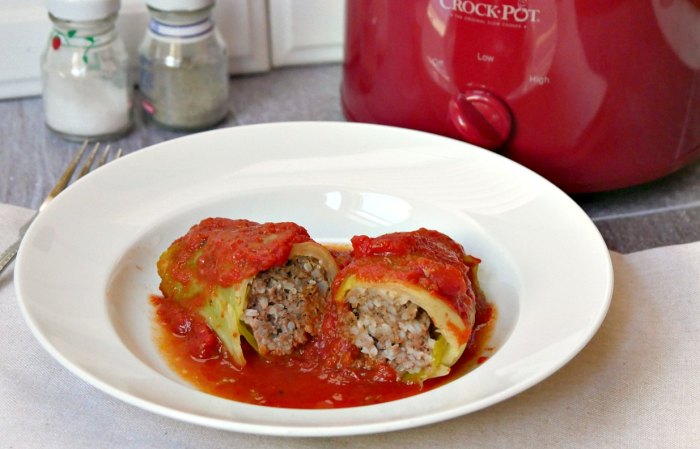
Stuffed cabbage rolls, a dish that encapsulates the essence of comfort food, are a culinary tradition cherished across various cultures. From the hearty flavors of Eastern Europe to the delicate nuances of Asian cuisine, these savory parcels have captivated taste buds for centuries.
This article delves into the origins and cultural significance of stuffed cabbage rolls, exploring the diverse ingredients and preparation methods that make this dish a global culinary treasure.
Variations in Ingredients and Preparation Methods
The beauty of stuffed cabbage rolls lies in their adaptability. Each region and culture infuses its unique flavors and culinary traditions into this versatile dish. The variations in ingredients and preparation methods create a kaleidoscope of culinary experiences, making stuffed cabbage rolls a truly global dish.
- Eastern Europe: In Eastern Europe, stuffed cabbage rolls are often called “golubtsy” or “holubtsi.” They typically feature a filling of ground meat, rice, and vegetables like onions and carrots. The cabbage leaves are blanched before being rolled around the filling and simmered in a rich tomato sauce.
The sauce often incorporates spices like paprika, bay leaves, and black pepper, adding depth and complexity to the dish.
- Middle East: In the Middle East, stuffed cabbage rolls, known as “dolma,” are often made with grape leaves instead of cabbage. The filling typically consists of a mixture of ground meat, rice, onions, and herbs like parsley and mint. The grape leaves are blanched and rolled around the filling before being simmered in a flavorful broth.
The broth may include ingredients like lemon juice, tomatoes, and spices like cinnamon and cumin.
- Asia: In Asia, stuffed cabbage rolls are often called “baozi” or “dumplings.” They typically feature a filling of pork, vegetables, and spices, wrapped in a thin dough made from flour and water. The baozi are steamed or fried until golden brown and crispy.
Ingredients and Preparation: Stuffed Cabbage Rolls With Tomato Sauce
The heart of any delicious dish lies in the quality of its ingredients and the care taken in preparing them. This holds true for stuffed cabbage rolls, where fresh, vibrant flavors and meticulous preparation are key to a truly satisfying meal.
Stuffed cabbage rolls with tomato sauce are a classic comfort food that always hits the spot. They’re hearty and filling, and the combination of savory cabbage, seasoned meat, and rich tomato sauce is just irresistible. For a lighter side dish, I often pair them with a simple rice dish like goya easy arroz con pollo , which adds a touch of Spanish flavor to the meal.
The rice absorbs the flavorful sauce from the cabbage rolls, making for a truly satisfying culinary experience.
Ingredients
A well-stocked pantry and a few fresh ingredients are all you need to create these savory cabbage rolls. Here’s a detailed list:
- Cabbage:Opt for a large, firm head of green cabbage. Look for leaves that are pliable enough to roll but sturdy enough to hold the filling. A fresh cabbage will have crisp leaves and a vibrant green color.
- Ground Meat:You can use ground beef, pork, or a combination of both. Choose a higher fat content for richer flavor and juiciness.
- Rice:Long-grain white rice is ideal for stuffing cabbage rolls. It absorbs the flavors of the filling and holds its shape well after cooking.
- Onion:A medium-sized onion, finely chopped, adds sweetness and depth to the filling.
- Garlic:Freshly minced garlic provides a pungent aroma and savory flavor.
- Tomato Paste:This concentrated tomato paste adds a rich, umami flavor to the sauce.
- Tomato Sauce:Choose a good quality tomato sauce for the base of your sauce. Look for a sauce that is not too watery and has a vibrant tomato flavor.
- Beef Broth:Adding beef broth to the sauce adds depth and richness.
- Spices:Use a combination of spices like paprika, oregano, marjoram, and black pepper to enhance the flavor profile of the filling and sauce.
- Salt and Pepper:Adjust the seasoning to your taste.
Preparing the Cabbage Leaves
Preparing the cabbage leaves is crucial for creating beautiful and manageable rolls. Here’s how to do it:
- Blanch the Cabbage:Fill a large pot with water and bring it to a rolling boil. Carefully add the cabbage head to the boiling water and blanch for 3-5 minutes. This will soften the leaves and make them easier to work with.
- Remove and Cool:Using tongs, remove the cabbage from the boiling water and place it in a bowl of ice water. This will stop the cooking process and ensure the leaves retain their vibrant green color.
- Separate the Leaves:Once the cabbage has cooled, gently peel off the outer leaves, starting from the bottom. Discard any damaged or torn leaves.
- Trim the Leaves:Trim the thick center vein from each leaf to prevent it from curling up while rolling.
Preparing the Filling Mixture
The filling mixture is the heart of the stuffed cabbage rolls. Here’s how to create a flavorful and satisfying filling:
- Cook the Rice:Cook the rice according to package instructions, but slightly undercook it. It should be al dente, as it will continue to cook in the sauce.
- Sauté the Onion and Garlic:In a large skillet, heat a little oil over medium heat. Sauté the chopped onion and minced garlic until softened and fragrant.
- Brown the Meat:Add the ground meat to the skillet and brown it thoroughly, breaking it up with a spoon.
- Combine the Ingredients:Combine the cooked rice, browned meat, onion and garlic mixture, tomato paste, spices, and salt and pepper in a large bowl. Mix well to ensure all the ingredients are evenly distributed.
Preparing the Tomato Sauce
The tomato sauce is the perfect complement to the savory filling. Here’s how to create a rich and flavorful sauce:
- Sauté the Onion and Garlic:In a large saucepan, heat a little oil over medium heat. Sauté the chopped onion and minced garlic until softened and fragrant.
- Add the Tomato Paste:Add the tomato paste to the saucepan and cook for a few minutes, stirring constantly, until it becomes fragrant and slightly caramelized.
- Add the Tomato Sauce:Pour the tomato sauce into the saucepan and stir to combine.
- Add the Beef Broth:Pour the beef broth into the saucepan and bring the sauce to a simmer.
- Season and Simmer:Season the sauce with spices, salt, and pepper to taste. Reduce the heat to low and simmer the sauce for 30 minutes, stirring occasionally, to allow the flavors to meld.
Flavor Profiles and Variations
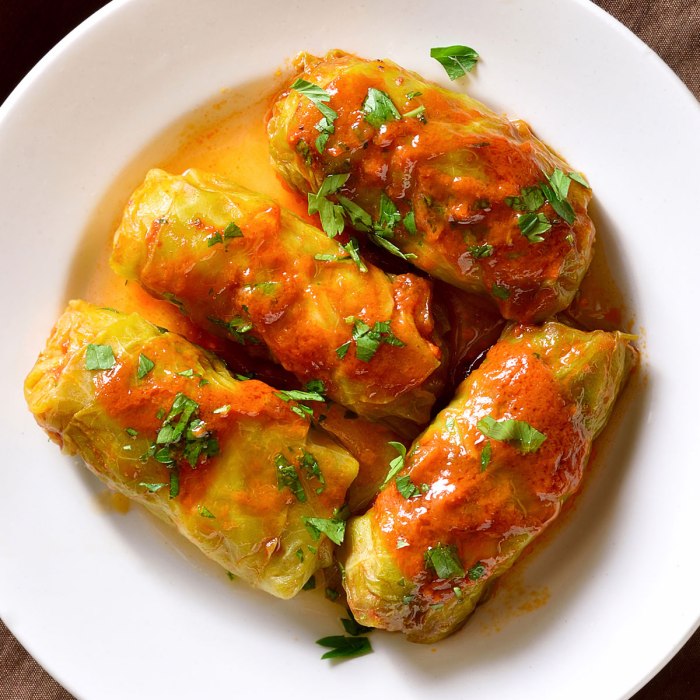
The flavor of stuffed cabbage rolls with tomato sauce is a harmonious blend of savory, sweet, and tangy notes, with a comforting warmth from the spices. The key components that contribute to this complex flavor profile are the meat filling, the cabbage leaves, the tomato sauce, and the aromatic spices and herbs.
Spice and Herb Combinations
The choice of spices and herbs can significantly impact the overall flavor of the dish. Commonly used spices include:
- Caraway seeds: Contribute a warm, earthy flavor with a hint of licorice.
- Cumin: Adds a warm, slightly bitter note with a hint of smokiness.
- Marjoram: Provides a sweet, slightly peppery flavor that complements the other spices.
- Paprika: Adds a sweet, smoky flavor with a vibrant red color.
- Black pepper: Adds a sharp, pungent flavor that balances the sweetness of the other ingredients.
These spices can be combined in various ways to create different flavor profiles. For example, a combination of caraway seeds, cumin, and marjoram will create a more traditional Eastern European flavor, while a combination of paprika, cumin, and black pepper will create a more robust and smoky flavor.
Variations and Alternative Ingredients
The classic stuffed cabbage roll recipe can be customized in countless ways. Some common variations include:
- Meatless options: For a vegetarian or vegan version, substitute the ground meat with lentils, quinoa, or a mixture of vegetables. Mushroom-based fillings are also popular.
- Different vegetables: Add other vegetables to the filling, such as carrots, celery, onions, or mushrooms, for added texture and flavor.
- Tomato sauce variations: Experiment with different types of tomato sauce, such as marinara, arrabbiata, or a homemade sauce with herbs and spices.
- Rice alternatives: Instead of rice, use quinoa, barley, or couscous for a different texture and nutritional profile.
- Citrus additions: A touch of lemon or orange zest can add a bright and refreshing note to the dish.
Cooking Techniques
The art of preparing stuffed cabbage rolls extends beyond the meticulous assembly of the filling and wrapping. The cooking method plays a pivotal role in achieving a tender, flavorful, and visually appealing dish. Several techniques, each with its own set of advantages and disadvantages, are commonly employed to cook stuffed cabbage rolls.
Simmering
Simmering is a gentle cooking method that involves cooking the stuffed cabbage rolls in a flavorful broth or sauce over low heat. The slow, even cooking process allows the flavors to meld and the cabbage to become tender without falling apart.
Stuffed cabbage rolls with tomato sauce are a classic comfort food, and they always seem to disappear quickly at any gathering. To round out the meal, I like to serve a big bowl of macaroni salad for a crowd , which adds a refreshing contrast to the hearty cabbage rolls.
The creamy macaroni salad is a perfect foil to the rich tomato sauce, and it’s a crowd-pleaser that everyone enjoys.
- Advantages:
- Simmering produces tender, flavorful cabbage rolls.
- It’s a hands-off cooking method, requiring minimal supervision.
- The slow cooking allows the flavors to develop and meld.
- Disadvantages:
- Simmering can take a longer time than other methods.
- It requires constant monitoring to ensure the broth doesn’t evaporate.
Baking
Baking stuffed cabbage rolls in the oven offers a convenient and flavorful way to prepare them. The oven’s dry heat allows the rolls to brown and crisp while the filling cooks through.
Stuffed cabbage rolls with tomato sauce are a comfort food classic, and there’s something so satisfying about the tender cabbage leaves enveloping the savory filling. For an extra layer of flavor, try using homemade sweet Italian sausage, either mild or hot, in your recipe.
You can find a great recipe for homemade sweet Italian sausage mild or hot online, and the difference in taste is truly remarkable. The sausage adds a richness and depth of flavor that will elevate your stuffed cabbage rolls to a whole new level.
- Advantages:
- Baking yields crispy, browned cabbage rolls.
- It’s a relatively hands-off cooking method, requiring minimal supervision.
- The oven’s dry heat allows for even cooking.
- Disadvantages:
- Baking can lead to dry cabbage rolls if not monitored closely.
- It requires a preheated oven, which can be time-consuming.
Pressure Cooking
Pressure cooking is a quick and efficient method for preparing stuffed cabbage rolls. The high pressure and steam inside the pressure cooker accelerate the cooking process, resulting in tender cabbage rolls in a fraction of the time.
- Advantages:
- Pressure cooking is a fast and efficient method for preparing stuffed cabbage rolls.
- It results in tender, flavorful cabbage rolls.
- It’s a hands-off cooking method, requiring minimal supervision.
- Disadvantages:
- Pressure cooking can be intimidating for some cooks.
- It requires a pressure cooker, which is a specialized appliance.
Serving Suggestions and Accompaniments
Stuffed cabbage rolls are a hearty and satisfying dish that can be enjoyed as a main course or a side dish. They pair well with a variety of side dishes and accompaniments, and the presentation can elevate the dining experience.
Here are some ideas for serving stuffed cabbage rolls to enhance their flavor and appeal.
Side Dishes
Side dishes complement the stuffed cabbage rolls, adding variety in flavors and textures. They can be light and refreshing, or rich and comforting.
- Mashed Potatoes:Creamy mashed potatoes provide a comforting contrast to the savory cabbage rolls. You can enhance the flavor with herbs like chives or parsley, or add a touch of garlic.
- Rice Pilaf:A simple rice pilaf with aromatic herbs like dill or parsley complements the dish. The fluffy rice provides a light and neutral backdrop for the flavorful cabbage rolls.
- Roasted Vegetables:Roasted vegetables, such as carrots, Brussels sprouts, or asparagus, offer a vibrant and healthy accompaniment. The roasting process brings out the natural sweetness of the vegetables, creating a delightful contrast to the savory cabbage rolls.
- Green Salad:A fresh green salad with a light vinaigrette adds a refreshing element to the meal. Choose leafy greens like romaine lettuce or spinach, and add colorful vegetables like tomatoes, cucumbers, and bell peppers.
Garnishes
Garnishes add a touch of visual appeal and enhance the flavors of the stuffed cabbage rolls.
- Fresh Herbs:Chopped fresh herbs like parsley, dill, or chives add a burst of flavor and color to the dish. Sprinkle them over the cabbage rolls before serving.
- Sour Cream or Yogurt:A dollop of sour cream or yogurt provides a tangy and creamy contrast to the rich flavors of the cabbage rolls.
- Lemon Wedges:Lemon wedges add a bright and refreshing touch to the dish. They can be squeezed over the cabbage rolls for a touch of acidity.
Presentation
The presentation of the stuffed cabbage rolls can elevate the dining experience.
- Plating:Serve the cabbage rolls on a platter or individual plates. You can arrange them in a circle or a line, with the side dishes and garnishes placed around them.
- Visual Appeal:Consider using a variety of colors and textures to create a visually appealing presentation. For example, you can use a green salad with colorful vegetables and a dollop of sour cream or yogurt as a garnish.
Beverage Pairings
The choice of beverage can complement the flavors of the stuffed cabbage rolls.
- Red Wine:A light-bodied red wine, such as Pinot Noir or Beaujolais, pairs well with the savory flavors of the cabbage rolls. The wine’s acidity cuts through the richness of the dish.
- White Wine:A dry white wine, such as Sauvignon Blanc or Pinot Grigio, can also be a good pairing. The wine’s crispness complements the flavors of the cabbage rolls without overpowering them.
- Beer:A light lager or pale ale can also be a good pairing, especially if the cabbage rolls are served with a side of mashed potatoes or roasted vegetables.
Nutritional Value and Health Considerations
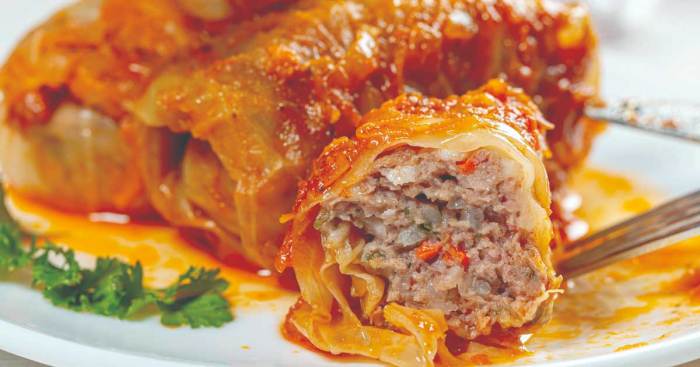
Stuffed cabbage rolls are a hearty and flavorful dish, but it’s essential to consider their nutritional content and potential health implications. While they can be a source of essential nutrients, certain factors can affect their overall healthfulness. This section will delve into the nutritional breakdown of stuffed cabbage rolls, exploring both their benefits and drawbacks.
It will also offer practical tips for making healthier versions of this classic dish.
Nutritional Content of Stuffed Cabbage Rolls
The nutritional content of stuffed cabbage rolls varies depending on the ingredients used. However, a typical serving of stuffed cabbage rolls often contains:
- Carbohydrates:Primarily from the rice, cabbage, and tomato sauce, providing energy.
- Protein:From the ground meat, providing building blocks for tissues and enzymes.
- Fat:From the ground meat and added fat, contributing to flavor and satiety.
- Vitamins and Minerals:Including vitamin C from cabbage, iron from ground meat, and potassium from tomatoes.
The exact amounts of these nutrients will vary based on the recipe and serving size.
Health Benefits of Stuffed Cabbage Rolls
While stuffed cabbage rolls are not a health food in the traditional sense, they can offer some health benefits when prepared with healthy ingredients and in moderation:
- Source of Fiber:Cabbage is a good source of dietary fiber, which can aid digestion and help regulate blood sugar levels.
- Rich in Antioxidants:Tomatoes are rich in lycopene, a powerful antioxidant that may protect against certain types of cancer.
- Protein Source:Ground meat provides protein, which is essential for muscle growth and repair.
Potential Drawbacks of Stuffed Cabbage Rolls, Stuffed cabbage rolls with tomato sauce
While stuffed cabbage rolls can be a part of a balanced diet, there are potential drawbacks to consider:
- High in Sodium:Tomato sauce and processed meats often contain high amounts of sodium, which can contribute to high blood pressure.
- High in Saturated Fat:The ground meat and added fat can contribute to high levels of saturated fat, which can increase the risk of heart disease.
- High in Calories:Stuffed cabbage rolls are typically high in calories, which can contribute to weight gain if consumed in excess.
Tips for Healthier Stuffed Cabbage Rolls
To make stuffed cabbage rolls healthier, consider these tips:
- Choose lean ground meat:Opt for lean ground beef, turkey, or chicken to reduce saturated fat content.
- Use low-sodium tomato sauce:Look for low-sodium or no-salt-added tomato sauce to reduce sodium intake.
- Add vegetables:Include a variety of vegetables like carrots, onions, and peppers to increase fiber and nutrient content.
- Reduce rice:Use less rice or substitute it with quinoa or brown rice for added fiber and nutrients.
- Cook without added fat:Avoid frying the cabbage rolls and opt for baking or steaming to reduce fat content.

